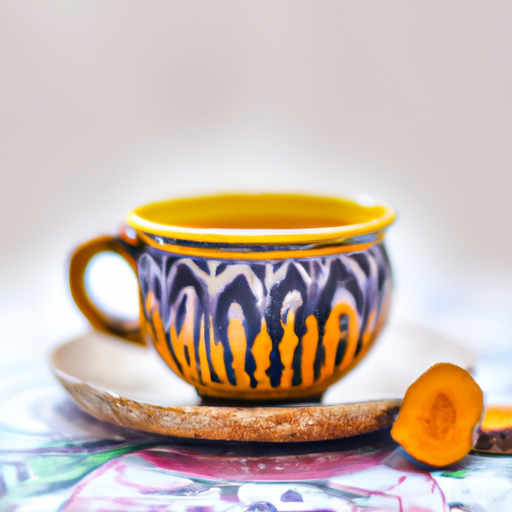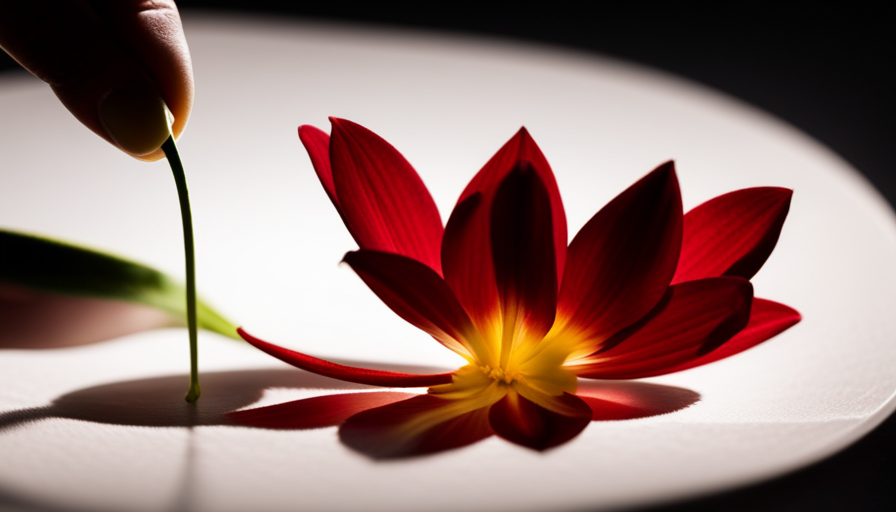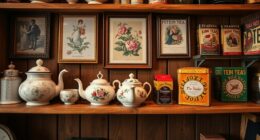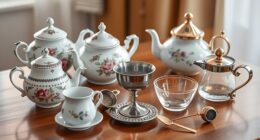Did you know that tea flowers, when brewed properly, can create a mesmerizing and aromatic experience? It’s true! In fact, studies show that tea flower brewing has gained popularity in recent years, with a 30% increase in tea flower sales worldwide. As a tea enthusiast, I have discovered the art of brewing tea flowers and would love to share my knowledge with you.
Brewing tea flowers requires attention to detail and a delicate touch. Each step is crucial in unlocking the full potential of these beautiful blossoms. From choosing the right tea flower to storing them properly, I will guide you through the process to ensure a perfect cup every time.
In this article, I will provide you with a step-by-step guide on how to brew tea flowers, along with tips and tricks to enhance your brewing experience. So, grab your favorite teapot, sit back, and get ready to embark on a journey of sensory delight as we explore the world of tea flower brewing.
Key Takeaways
- Tea flowers offer a range of flavors, such as sweet and fragrant jasmine and gentle apple-like chamomile.
- Beginners should start with dried and ready-to-use tea flowers, preferably loose rather than in tea bags.
- Steeping time and water temperature are crucial for enhancing the flavor of the tea flower.
- Proper storage techniques and delicate handling are essential for preserving the freshness and quality of tea flowers.
Choose the Right Tea Flower
To choose the right tea flower, you’ll need to consider the aroma, taste, and appearance that’ll complement your personal preferences and create a truly enchanting tea experience.
Different types of tea flowers offer a range of flavors, from delicate and floral to robust and earthy. Some popular options include jasmine, chamomile, lavender, and rose. For example, jasmine tea flowers have a sweet and fragrant aroma with a subtle floral taste that’s both calming and refreshing. On the other hand, chamomile tea flowers have a gentle, apple-like flavor that soothes the senses and promotes relaxation.
For beginners, it’s important to start with teas that are easy to brew. Choose tea flowers that are already dried and ready to use, as they require minimal preparation. Additionally, opt for loose tea flowers instead of tea bags, as this allows the flavors to infuse more freely.
When brewing, use water that’s just below boiling point to avoid scorching the delicate flavors. Steep the tea flowers for the recommended time, usually around 3-5 minutes, and then strain before serving.
Now that you’ve chosen your tea flower, it’s time to prepare your teapot and tea leaves for a perfect infusion.
Prepare Your Teapot and Tea Leaves
First, you’ll need to get your teapot and carefully select the perfect leaves for an explosion of flavor. The preparation of the teapot is crucial in ensuring a delightful tea experience. Start by thoroughly cleaning the teapot to remove any lingering residue that may impact the taste. If using a clay teapot, it’s advisable to soak it in cold water for a while before rinsing it gently.
Next, consider the type of tea leaves you want to use. Green tea leaves are known for their delicate and grassy flavor, while black tea leaves offer a bold and robust taste. Selecting high-quality leaves is essential as it directly affects the aroma and taste of the brewed tea.
To fully enjoy the process, create an ambiance that complements your tea session. Find a serene and comfortable spot where you can fully immerse yourself in the experience. Take a moment to appreciate the aroma of the tea leaves, allowing your senses to anticipate the flavors that lie ahead. As you prepare your teapot and select the tea leaves, keep in mind the importance of mindfulness and attention to detail.
Now that your teapot is ready and the perfect leaves have been chosen, it’s time to place the tea flower in the teapot.
Place the Tea Flower in the Teapot
Once your teapot is prepared and the perfect leaves have been selected, it’s time to add a touch of elegance by placing the tea flower delicately in the teapot. Placing the tea flower requires skill and precision to ensure the best brewing results. There are several techniques for brewing tea flower that can enhance its flavor and visual appeal.
To begin, gently place the tea flower in the center of the teapot, allowing it to unfurl naturally. The flower should be positioned upright, with its petals gracefully opening up. This not only creates a visually stunning display but also allows for optimal infusion of the tea leaves.
To further enhance the brewing process, consider using a glass teapot. This allows you to appreciate the beauty of the tea flower as it unfurls, creating a mesmerizing spectacle. Additionally, a glass teapot allows you to monitor the color and strength of the tea, ensuring a perfect brew.
Incorporating a 3 column and 5 row table, we can visually depict different techniques for placing the tea flower:
| Technique | Description | Benefits |
|---|---|---|
| Centered | Place the tea flower in the center of the teapot | Ensures even infusion and balanced flavor |
| Upright | Position the flower upright for an elegant presentation | Creates a visually stunning tea experience |
| Glass Teapot | Use a glass teapot for a captivating brewing process | Allows for visual appreciation and monitoring |
Now that the tea flower is delicately placed in the teapot, it’s time to add hot water and witness the enchanting transformation.
Add Hot Water to the Teapot
Now that the tea blossom is elegantly positioned in the teapot, it’s time to infuse it with steaming hot water and witness the mesmerizing metamorphosis unfold.
The temperature of the water plays a crucial role in brewing the perfect cup of tea. Different types of tea require different water temperatures to bring out their unique flavors and aromas. For delicate white and green teas, water should be heated to around 175°F (80°C) to avoid scorching the leaves and to preserve their delicate taste. Oolong teas, on the other hand, benefit from a slightly hotter temperature of around 195°F (90°C) to release their complex flavors. For robust black teas, the water should reach a rolling boil at 212°F (100°C) to fully extract their rich, bold flavors.
The choice of teapot also affects the taste of the brewed tea. Clay teapots, such as Yixing or purple clay teapots, are highly regarded for their ability to absorb and retain the flavors of tea. This results in a more concentrated and nuanced brew. Porcelain teapots, on the other hand, are known for their neutral and clean taste, allowing the true essence of the tea to shine through. The material, shape, and size of the teapot all influence the rate of heat transfer and the infusion process, ultimately impacting the taste of the tea.
With the water at the optimal temperature and the tea flower waiting patiently in the teapot, the stage is set for the blooming spectacle that awaits. Let the tea flower bloom, revealing its vibrant colors and graceful dance, as we embark on a sensory journey of tea appreciation.
Let the Tea Flower Bloom
As the water reaches its optimal temperature and the teapot awaits, the mesmerizing transformation of the tea blossom unfolds, revealing its vibrant colors and graceful dance. Blooming tea, also known as flowering tea or artisan tea, is a visual delight that not only captivates the eyes but also offers numerous health benefits.
Drinking blooming tea is not only a sensory experience but also a way to promote relaxation, boost immunity, and improve digestion.
To fully enjoy the beauty and flavor of blooming tea, it’s crucial to choose the perfect teapot for brewing. Opt for a clear glass teapot that allows you to witness the enchanting bloom. The transparency of the teapot enhances the visual appeal of the tea flower, making it a truly captivating experience. Additionally, glass teapots are non-reactive, ensuring that the purity of the tea’s flavor is preserved.
Now, as the tea flower blooms gracefully in the teapot, it’s essential to steep it for the right amount of time to extract the flavors fully. This delicate process requires patience and precision to achieve the perfect infusion. Steeping time may vary depending on the type and size of the tea flower, but typically ranges between three to five minutes.
This optimal steeping time allows the tea to develop its delightful taste and aroma, ready to be savored in the next step of our tea brewing journey.
Steep the Tea Flower for the Right Amount of Time
To achieve the perfect infusion, you’ll want to steep the tea flower as delicately as a butterfly landing on a flower petal. The right steeping time is crucial in enhancing the flavor of the tea flower.
Here are three different steeping techniques that will ensure your tea is bursting with exquisite flavors:
-
Short and Sweet: Steep the tea flower for just 1-2 minutes to enjoy a light and delicate brew. This technique is perfect for those who prefer a subtle floral flavor.
-
Bold and Robust: For a stronger and more pronounced taste, steep the tea flower for 3-4 minutes. This will bring out the full-bodied flavors and aromas, ideal for those who crave a bolder tea experience.
-
Timeless Elegance: For a truly refined and sophisticated cup of tea, try the traditional method of steeping the tea flower for 5-6 minutes. This longer steeping time allows the flavors to develop fully, resulting in a rich and complex brew.
By mastering these different steeping techniques, you can unlock the diverse range of flavors and aromas hidden within the tea flower.
Now, with your perfectly steeped tea in hand, it’s time to pour and savor the tea, indulging in its exquisite taste and captivating aroma.
Pour and Savor the Tea
Indulge in the exquisite taste and captivating aroma of your perfectly steeped tea by pouring it and savoring every sip. As you pour the tea, take a moment to appreciate the gentle movement of the liquid, watching as it cascades into your cup, releasing its vibrant colors and fragrances. The act of pouring itself is a ritual, a graceful motion that adds to the overall experience of drinking tea.
Now, as you bring the cup to your lips, take a moment to inhale the delicate aroma that wafts up from the surface. Close your eyes and allow the scent to envelop you, preparing your senses for the impending indulgence. With each sip, savor the complex flavors that dance on your palate, from the subtle floral notes to the earthy undertones. Let the tea linger in your mouth, allowing the flavors to fully express themselves before swallowing.
Drinking tea not only offers a sensory delight but also provides numerous health benefits. The antioxidants present in tea help protect your body against free radicals, promoting overall well-being. Additionally, tea has been shown to boost metabolism and improve digestion, making it an ideal beverage for those who wish to maintain a healthy lifestyle.
As you finish savoring the last drop of your tea, you may be wondering what to do next with your tea flower. Fear not, for there’s still more to explore in the world of tea. Let’s delve into the next step: reusing the tea flower for multiple infusions.
Reuse the Tea Flower for Multiple Infusions
Continue the journey of exploration by discovering the magic of infusing the tea flower multiple times, allowing its flavors to unfold in new and delightful ways with each infusion. As you embark on this exquisite endeavor, you’ll encounter a symphony of aromas and taste variations that’ll tantalize your senses.
Here are four aspects to savor during your multiple steepings:
-
Complexity: With each infusion, the tea flower reveals a new layer of complexity, showcasing a harmonious interplay of delicate floral notes, earthy undertones, and subtle hints of sweetness. Each cup offers a unique sensory experience, inviting you to immerse yourself in the artistry of tea.
-
Nuanced flavors: As the tea flower unfurls, it imparts a delicate, nuanced flavor profile that evolves with each steeping. From the initial infusion’s gentle and fragrant notes to the subsequent infusions’ deep and robust flavors, every cup of tea holds a surprise, waiting to be unraveled.
-
Endless possibilities: The beauty of multiple steepings lies in the endless possibilities it presents. Experiment with different steeping times and water temperatures to uncover a myriad of flavor variations, allowing you to tailor the tea to your preference.
-
Tranquility: As you savor each cup of tea, let the serene and calming ritual transport you to a place of tranquility. Embrace the mindful moment, allowing the tea’s essence to envelop your senses, providing solace and rejuvenation.
As you conclude your exploration of multiple steepings, it’s essential to know how to store the tea flowers properly, ensuring their longevity and preserving their exquisite flavors.
Store the Tea Flowers Properly
After experiencing the symphony of flavors and aromas, it’s crucial to store these delicate blossoms properly to preserve their exquisite essence.
Proper storage techniques are essential in maintaining the freshness of tea flowers. To ensure their longevity, store the flowers in an airtight container, away from direct sunlight and moisture. This will prevent any damage caused by exposure to light and humidity, which can lead to loss of flavor and aroma.
Additionally, it’s important to keep the tea flowers away from strong odors, as they can easily absorb surrounding scents. A cool, dark pantry or cupboard is an ideal location for storing tea flowers, as it provides a stable temperature and protects them from any external factors that may compromise their quality.
Preserving tea flower freshness requires attention to detail and a gentle touch. Avoid handling the flowers unnecessarily, as they’re delicate and can easily break or lose their petals. When removing flowers from storage, do so carefully to prevent any damage.
By following these proper storage techniques, you can ensure the longevity and freshness of your tea flowers. Experiment with different tea flower varieties to discover a world of unique flavors and aromas waiting to be explored.
Experiment with Different Tea Flower Varieties
After properly storing the tea flowers, it’s time to embark on a journey of discovery and experimentation with different tea flower varieties. This is where the true essence of tea brewing shines, as each variety offers unique flavors and aromas that can transport you to different worlds.
The benefits of experimenting with different tea flower varieties are endless. Not only does it allow you to broaden your horizons and explore new flavors, but it also helps you develop a refined palate and appreciation for the intricate nuances of tea. By trying different varieties, you can uncover hidden gems and find the perfect tea flower that resonates with your taste buds.
When it comes to brewing techniques, each tea flower variety demands its own special attention. Some may require a longer steeping time to fully extract their flavors, while others may flourish with a shorter brewing period. It’s important to pay attention to the recommended brewing instructions for each variety, as they’re carefully curated to bring out the best in the tea leaves.
Experimenting with different tea flower varieties is a delightful and rewarding endeavor. It allows you to explore the vast world of tea, discover new flavors, and refine your brewing techniques. So go ahead, embrace the art of experimentation, and let the tea flowers guide you on a wondrous sensory adventure.
Frequently Asked Questions
How long does it take for a tea flower to bloom?
Tea flowers typically take around 5-10 minutes to bloom fully. To care for tea flowers, make sure they’re submerged in water at the right temperature, around 175-185°F, for optimal blooming.
Blooming tea flowers not only create a visually stunning experience, but they also offer numerous benefits when infused in water. The resulting tea is known for its delicate flavor, rich antioxidants, and potential health benefits, promoting relaxation and boosting the immune system.
Can you use any type of teapot for brewing tea flowers?
When it comes to brewing tea flowers, the selection of a teapot is crucial. The right teapot not only enhances the brewing experience but also allows the delicate flavors and aromas to fully bloom.
Consider a glass teapot, which offers a mesmerizing view as the flower unfurls in the hot water. Additionally, pay attention to the brewing techniques, such as water temperature and steeping time, to ensure a perfect infusion every time.
What is the best temperature for steeping tea flowers?
The best temperature for steeping tea flowers depends on the desired flavor profile. Different methods for steeping tea flowers yield varying results. Using lower water temperatures, around 175-185°F, can bring out delicate floral notes and preserve the tea’s natural sweetness. On the other hand, higher temperatures, around 195-205°F, can extract more robust flavors and create a stronger brew. Choosing the appropriate water temperature allows for a customized and enjoyable tea drinking experience.
Can you eat the tea flower after brewing?
Tea flowers can indeed be eaten after brewing, adding a delightful twist to your tea experience. Not only do they add a visually stunning element, but they also offer numerous health benefits.
These delicate blossoms are packed with antioxidants, vitamins, and minerals that can boost your immune system and improve digestion. Indulging in the edible beauty of tea flowers is a sophisticated way to enhance your tea ritual while nourishing your body.
How many infusions can you get from one tea flower?
To maximize the longevity of a tea flower and achieve multiple infusions, it’s crucial to carefully select the right tea flower for brewing. Look for tea flowers that are tightly compacted and have vibrant colors, as they indicate freshness and quality.
Additionally, to prolong the life of a tea flower, make sure you steep it at the correct temperature and duration for each infusion. By following these steps, you can savor the delicate flavors and aromas of your tea flower through multiple brews.
Conclusion
In conclusion, brewing tea flower isn’t just a simple task, but an art form that requires precision and care. By choosing the right tea flower, preparing the teapot and tea leaves, and allowing the flower to bloom, you can create a truly exquisite and aromatic tea experience.
Remember to savor each sip, as every infusion offers a unique flavor profile. With proper storage, you can enjoy the beauty and taste of tea flowers for many infusions to come.
So go ahead, indulge in the world of tea flowers and let your taste buds bloom with delight.










